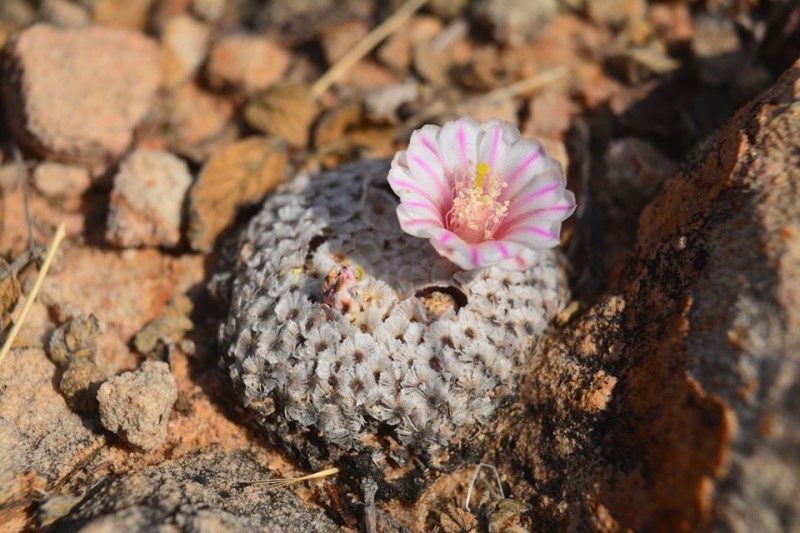Mammillaria breviplumosa García-Mor., Ramírez-Chap., Sigala-Chav. & Iamonico sp. nov. (Fig.1).
Holotype:—MEXICO. Durango State, Municipality of Mapimí, matorral xerófilo micrófilo, 1525 m, 05 December 2016, García-Morales
et al. 6344 (holotype ITCV!, isotypes CIIDIR!, GBH!, HFLA!).
Diagnosis:—Mammillaria breviplumosa is similar to M. sanchez-mejoradae Rodrigo González. (1992: 55) and M. hermosana Linzen, Ten Hoeve & Mart.-Avalos in Linzen (2014: 2–9) from which it differs in having a higher number of radial spines (40‒55 vostro. 30‒40 and 22‒30 respectively), the cylindrical tubercles with truncate apexes (vostro. conical and cylindrical in the other two species), the papillose epidermis of the tubercles (vostro. naked), the smaller flowers (14‒16 mm in diameter vostro. 16‒20 mm in M. sanchez-mejoradae, and 20‒23 mm in M. hermosana), smaller and oval areoles (0.8‒1.0 × 0.5 vostro. 1.3‒1.5 circular, and 1 × 2 mm circular), and the fruit ovoid, 3‒5 × 2‒3 mm (vostro. subsphaerical, and 3‒8 mm in diameter in both the other two species).
Description:—Stems simple, 10‒25 mm long, 20‒30 mm in diameter, depressed usually at soil level, with the older tubercles and most of the stem hypogeous; epigeous chlorophyllic section of the stem 5‒10 mm high; roots fibrous, slightly napiform in older plants. Tubercles arranged in 18 or 24 helicoidal series, cylindrical, 3‒4 mm high and 1‒2 mm diameter; imbricate and flattened when drought, appressed dorsally and ventrally; apexes truncate, epidermis papillose, pale green to dark green. Axils naked. Areoles oval, small, about 0.8‒1 mm long and 0.5 mm wide, with sparse trichomes in the margins at the base of spines, yellow to pale brown colored when young, later becoming grayish. Spines 40‒55, aciculate, all radiated, almost straight except at the slightly deflexed bases, cylindrical, 1.5‒2.2
mm long, white, pubescent; trichomes single, flattened, denser, longer and more tortuous at the spine apexes, taking shape of a short feather; spine epidermis very finely punctate-striated. Flowers widely infundibuliform-campanulate, 14‒16 mm diameter and 12‒16 mm long. External perianth segments 10‒12, the basal rhomboid to squamiform, the upper oblanceolate, with the apexes rounded or obtuse, 7‒10 mm long and 2‒3 mm wide, white to pale pink, with the external midstripe green to reddish. Internal perianth segments 12, oblanceolate or sometimes spathulate, with rounded apex, margins entire, 7‒10 mm long and 2‒3 mm wide, white with a midstripe pink to magenta. Stamens 60‒100, filaments white, glossy, 5‒8 mm long and 0.1‒0.2 mm in diameter; anthers pale yellow, 0.6‒0.8 mm long. Style green, 8‒10 mm long and 0.6‒0.8 mm in diameter; stigma lobes 3‒5, 1 mm long and 0.5 mm in diameter, dull green. Ovary naked, ovoid, 3‒5 mm long, light green, ovary walls 1 mm thick. Fruit embedded in the stem, ovoid, 3‒5 mm long and 2‒3 mm wide, flattened between the tubercles, green, with membranaceous epidermis. Seeds pyriform, testa black, with a constricted area above the hilum-micropylar region, 0.8‒1 mm long, 0.6‒0.8 mm in diameter, epidermis rugose, testa cells isodiametric, gradually smaller towards the hilum area, mostly penta-hexahedrical in shape, with verrucose surface; hilum basal, medium.
Etymology:—The specific epithet refers to the shape and distribution of the trichomes at the apexes of the spines, that resemble a small feather.
Distribution and habitat:—Endemic to a very small area in the Chihuahuan Desert (Municipality of Mapimí, Durango State, north Mexico) between 1450‒1550 m elevation. The habitat corresponds to small hills with a transition of Larrea-Mimosa shrubland, characterized by mainly Yucca, Opuntia and Fouquieria species. Geology of the area corresponds to Upper Jurassic rocks with soils derived from quartz and limestones (INEGI 1978). Note that the geographic distance between Mammillaria breviplumosa and M. sanchez-mejoradae is about 400 km straight line northwards, meanwhile the first from M. hermosana is more than 300 km straight line northwards.
Phenology:—Mammillaria breviplumosa flowers in winter, in February and early March; fruits seem to mature in the following year, but remains embedded in the stem between the older tubercles for many years until the fruits break up and seeds fall out the stem.
Conservation status:—The estimated population of Mammillaria breviplumosa consists of about 4000 plants. EOO (= Extent of Occurrence) covers about 2.5 km2, while the known AOO (= Area of Occupancy) is about 4 km2.
Based on field observations, threats to the species are mainly by uncontrolled cattle grazing. Because only a single effective population may exist and the habitat is subject to ongoing anthropogenic damage, application of the Red List Criteria of IUCN (2019) yields a conservation status estimate of Critically Endangered [CR B1a(iii)bc+B2a(iii)bc] for M. breviplumosa.
Taxonomic notes:—Following the treatments by Hunt (1971, 2006), Luthy (1995), and Pilbeam (1999),
Mammillaria breviplumosa should belong to the subgen. Mammillaria ser. Lasiacanthae Hunt (1971: 63). Representatives of this series are usually depressed-globose and clustering plants, with the stems completely hidden or almost so by the numerous radial spines, lacking central spines; the flowers are small (rarely exceeding 20 mm in length), mostly pale pink, creamy yellow or white; the seeds are black (Hunt 1971). Note, however, that the infrageneric classification of Mammillaria is not yet completely resolved (see e.g., Butterworth & Wallace 2005, Bárcenas et al. 2011, VázquezSánchez et al. 2013) and further investigations are needed to clarify it (García Morales & al. in prep.).
A diagnostic key for the species of Mammillaria ser. Lasiacanthae occurring in northern Mexico [M. breviplumosa, M. hermosana, M. roemeri Wolfg.Krüger & W.Rischer (2002: 96), M. lasiacantha Engelmann (1856: 5), M. magallanii Schmoll ex. R.T.Craig (1945: 225), M. plumosa Weber in Bois (1898: 804), M. sanchez-mejoradae] is here proposed.
Mammillaria breviplumosa in habitat



